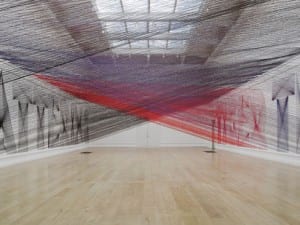In the Special 60th Edition of Aesthetica we celebrate the emerging photographers that are shaping the future of the image-based practice in The Next Generation. We have partnered with the London College of Communication to survey some of photography’s rising stars and showcase their fresh ideas and new concepts. Katie Bret-Day is influenced by the work of the Surrealists and has an interest in the materiality of photography. She has an affection for the traditional format of photography, but likes to combine this passion with digital methods to produce new and provocative pieces. Bret-Day speaks to us about the practitioners that have inspired her and how she communicates with her audience.
A: Your work is very experimental, why do you produce art in this way?
KBD: I have always had a very physical relationship with imagery, exploring the materiality of the image, its fragility and transience, the medium as whole. Within our current digital age I am a nostalgist, and believe it is important not to lose the origins of the photograph. However I feel it is important to integrate these methods with digital technologies in order to maintain the traditional photographic as a relevant process. This is where one element of experimentation comes into play. I often choose to interact with the image manipulating both the final photograph itself through cutwork etc. and also via other processes prior to printing. Through this I aim to reassert the material importance of the photograph, both its transient and tangible existence.
A: Your image Untitled/Automatic currently features in Issue 60 of Aesthetica, what is the concept behind the work?
KBD: The piece was part of an unpublished photographic book, exploring the “pure psychic automatism…” (Breton, 1924) of the surrealist image. Working in an unconscious, dreamlike manner I produced a series of female portraits “bearing only traces of organisation”. (Breton, 1924) Every portrait is irrational, each created from the logical ashes of its predecessor. I let my mind wander and created a book designed by a domino effect of style and composition. No introduction, only Breton’s words “I surrender to those who read me with their eyes open”. The viewer is left to decipher my unconscious or simply surrender to the aesthetics of the image and the page. An un-calculated representation of the female portrait, an automatic face.
A: Apart from the surrealists, which photographers inspire you?
KBD: Producing a definitive list of all the photographers that have inspired me throughout my practice would be almost impossible. However, there are a few who stand out as having inspired and influenced me within my recent work. Mariah Robertson’s expanses of colour and shape, Nadav Kander’s etherial bodies, Helen Chadwick’s multimedia montage, Adam Fuss, Frederic Fontenoy, Hugh Turvey, Michal Macku, and John Stezaker (the photographer who first triggered my interest in the photograph’s materiality).
A: What do you want your audiences to take from your work?
KBD: I believe every project I undertake has a different objective. My work is often abstract and so it is left open to a degree of interpretation. Some projects may use the photographic as a narrative means of discussing our contemporary condition, others may be intended as aesthetic tributes and explorations of the photographic medium. I hope that my work engenders emotion, whether it be pleasure, repulsion or intrigue. I would like my work to go beyond the ordinary and hopefully leave an impression. There is also a desire for the audience to remember the objecthood and importance of the photograph. To remember that it hasn’t always been, and still isn’t, just a disposable image suspended in a matter of pixels, infinitely reproduced then forgotten. There is a tangible vitality within the photographic, it is precious and I believe we should never take it for granted.
A: What do you have planned for next?
KBD: I am currently working on a new body of work for the Brighton Photo Fringe. Working as part of a collective, we are exploring Dissociative Identity Disorder. More commonly known as multiple personality disorder it is characterised by at least two distinct and relatively enduring identities that alternately control a person’s behaviour. I am particularly focused on exploring the mind-body conflict, exploring the possibilities of the body as a pure facilitator, incubating the conscious self, or selves as the case may be. Still in its early stages I am excited to see where this project takes me.
To find out more about Katie Bret-Day’s practice, visit www.katiebretday.com.
To see her work in Aesthetica Issue 60, head to www.aestheticamagazine.com.
Credits
1. Katie Bret-Day, Untitled/ The Automatic Farce, 2012.
Follow us on Twitter @AestheticaMag for the latest news in contemporary art and culture.





